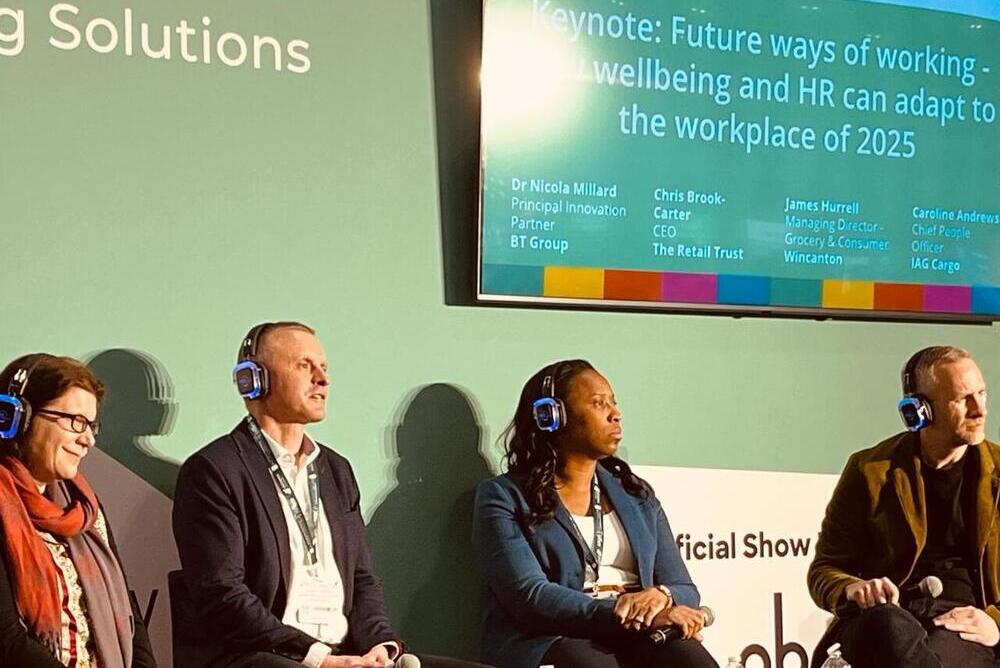While one speaker started by lamenting the lack of a crystal ball to predict the future, we reckon this session gave an excellent guess at big trends to watch when considering the future of work and how that impacts on wellbeing.
Arguably, with technology accelerating at a quicker pace than ever before (hello, AI) and the workplace transforming at an unprecedented rate (thank you, global pandemic) this topic is more front of mind than it’s ever been.
We’ve rounded up the key insights that this esteemed panel – Nicola Millard, Principal Innovation Partner, BT Group, James Hurrell, Managing Director, Wincanton and Caroline Andrews Chief People Officer, IAG Cargo – believe will be the most important in shaping what work will look like:
- A continued drive towards flexibility
- An increasingly emotionally intelligent leadership
- An aging workforce
- AI/ robotics
1. A continued drive towards flexibility
The pandemic changed the face of work overnight in terms of flexibility and the homeworking revolution. Now, says Millard, we are in a “really interesting state of flux”.
There’s often a “struggle between employers wanting people back in the office and employees maybe being slightly more reluctant to come back”. The challenge going forward for companies, as she says, will be finding the combination which works best, which she predicts for the vast majority will be hybrid working:
“We’re in an interesting situation at the moment in terms of trying to feel our way through these new ways of working. In some senses, the traditional ways of working are almost colliding with some of the newer ways of working and we’re still trying to figure out how to make work work.”
Tension between management homeworkers and onsite workers
For her, success comes back to analysing the data and “cutting through some of the emotive stuff” to find what is working best.
As Hurrell pointed out in some cases, there can be a tension between the ability to offer more flexible homeworking options to the management staff, which can’t be offered to those employees who need to be on site, like warehouse workers in his case. The big challenge here going forward is to, he says, “be really mindful that we don’t want to have a culture where some colleagues are in the depots, doing the work, and the management are at home on Microsoft Teams because that doesn’t work”. Employers need, in these cases, to find a way to “connect the two” and “create a collective purpose”.
Days of ‘what’s in the contract?’ are over
As for Andrews, she believes that “there’s a different degree of confidence amongst employees to articulate what works for them and what they’re looking for from an employer; so the days of it being about ‘what is a reasonable request and what’s in the contract?’ are over,” she says. As a result, if employers want to attract and retain top talent they must, she says, forge “an emotional connection with employees to unlock a level of goodwill to really make that difference”.
But this employee demand for flexibility isn’t just around location or hours, it’s increasingly manifesting in things like wellbeing benefits and policies too. “It’s about recognising how lifestles and the way in which people do things, including in their personal lives, has changed and how they influence your benefit offering. One of the things we’ve done, for example, is introduce a 24/7 GP service to support colleagues,” she says.
2. An increasingly emotionally intelligent leadership
Related to this new tension between the employer and employee around flexibility is the issue of culture and the reality that this is driven – not by policies or packages – but ultimately by leadership. So, to forge this required emotional connection with employees in today’s world of work leaders need to be “upskilled” says Andrews to be able to listen to and meet their needs.
“Without those leadership skills, and people management skills, that enable the needs of both employees and the organisation to be met in a really cohesive way, it’s going to be very difficult to compete effectively because of the war on talent,” she says.
Leadership struggling
Millard agrees, saying “leadership is definitely one of the things that we’re seeing a lot of organisations struggle with, particularly leaders that are having to lead teams that they don’t necessarily see on a regular basis”. As she says, the hybrid model is a complex one to “get right” and that is what employers are grappling with now.
‘Messy’ meetings
Currently, as we work towards a future that works, some of the ways of working definitely aren’t working – she gives the example of “messy” hybrid meetings with some employees in an office at work and some dialing in from home. She recalls situations where the “virtual” people are forgotten and end up messaging each other in the chat, underlying the teething issues happening now in hybrid.
Again, leadership is a challenge here, she says: “To be honest, we don’t teach our leaders to moderate meetings in the real world very well, so how do we actually then teach them to manage that extra level of complexity and orchestrate and moderate a hybrid meeting? That is a microcosm of some of the challenges we are struggling with in terms of leadership”.
3. An aging workforce
“I think the big disruptor is actually, potentially, retirement age,” says Millard.
She explains that, as we are having longer working lives, the normal “linear” progression that we’re used to changes significantly. We’re used to, for example, getting a lot of training and education at the beginning of our working lives but – as Millard asks – “if that linear path is disrupted, what does that mean? Does it mean continuous retraining during a career? Does it mean retiring a lot later? Will that have a huge implication on employers?”
Helping employees thrive and be future-fit
Andrews is already tackling this issue with an intentional focus on “how to multi skill certain populations in our organisation”: “That means giving them the ability to have fit-for-future skills and capabilities which will really help us evolve in an efficient way to meet our organisational needs”.
She touches on a key wellbeing issue here: the need to develop employees so they feel like they are building skills as well as valued:
“So, at one end of the spectrum it’s about how do you support employees working beyond traditional retirement age? Then at the other end of the spectrum, it’s about growing your emerging talent, and how you cater for that and for the challenges and tensions between different populations.”
4. AI/ robotics
Of course, AI (artificial intelligence) is another big disruptor which will also impact on the skills employees will need to thrive in future.
“In the ideal situation, AI takes away the boring and mundane work and allows us to do the more interesting, really human work,” says Millard. AI is actually going to make “human skills” much more important in future “because those are the skills that AI doesn’t do very well”.
AI means human tasks are more complex
This also affects the training and development issue, relevant to both employee wellbeing and organisational success: employees need to be upskilled to work most effectively with new tech like AI. “Also, with humans collaborating a lot more with AI there are lots of other layers around how we think about work, maybe in a slightly different way”.
Another massive impact of AI in terms of skills is that – as the tech scoops up the more repetitive, mundane, automatic tasks – humans are left with the much more “complex and emotive” work, says Millard. Talking in the context of contact centres, she explains that:
“You need people who are experts in their field and good at talking to people because a fair portion of that can’t be automated and we’re seeing a lot of what we term ‘customers in crisis’ at the moment particularly in areas like utilities and financial services, where people are struggling financially and they’re contacting the organiasation in extreme distress. It’s very difficult to automate that.”
Employees need support with AI info overload
So, in future, rather than take human jobs, AI is actually paving the way for jobs which are “alot more complex and a lot more human”, says Millard. Andrews has seen the same – human judgment rising in importance – because of AI.
She’s also seen a growing need to support employees using AI to manage the “extraordinary” amount of information now being generated, leading to the launch of a new ‘learning academy’ as a commitment to continuous learning.
The robots are here, and we’re loving them!
As for Hurrell, his focus has been on robotics. Initially worried about employees feeling the “robots were coming to take their jobs”, their introduction has been embraced by colleagues and led to the creation of some new roles around engineering and technology.
For now, at least, humans and robots are working in harmony, says Hurrell: “It’s fascinated and excited our people. We do tend to have fairly high attrition in a warehouse environment but not a single colleague in the Rochdale team, whose worked with the robots, has left. Not a single one, which is quite remarkable!”
You also might like:















